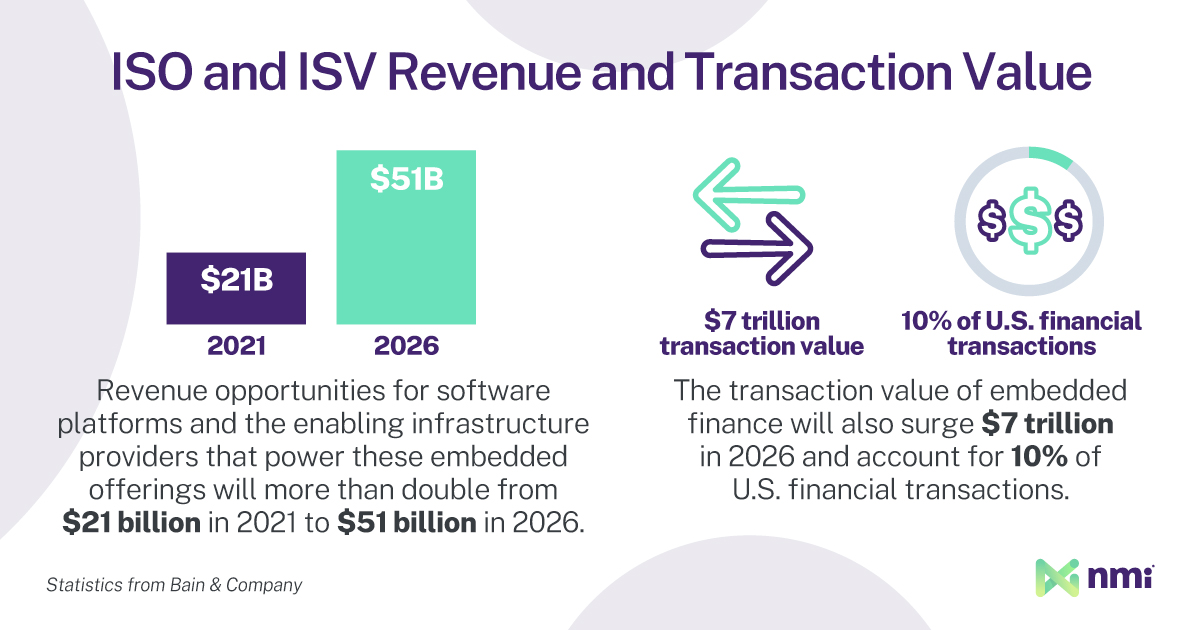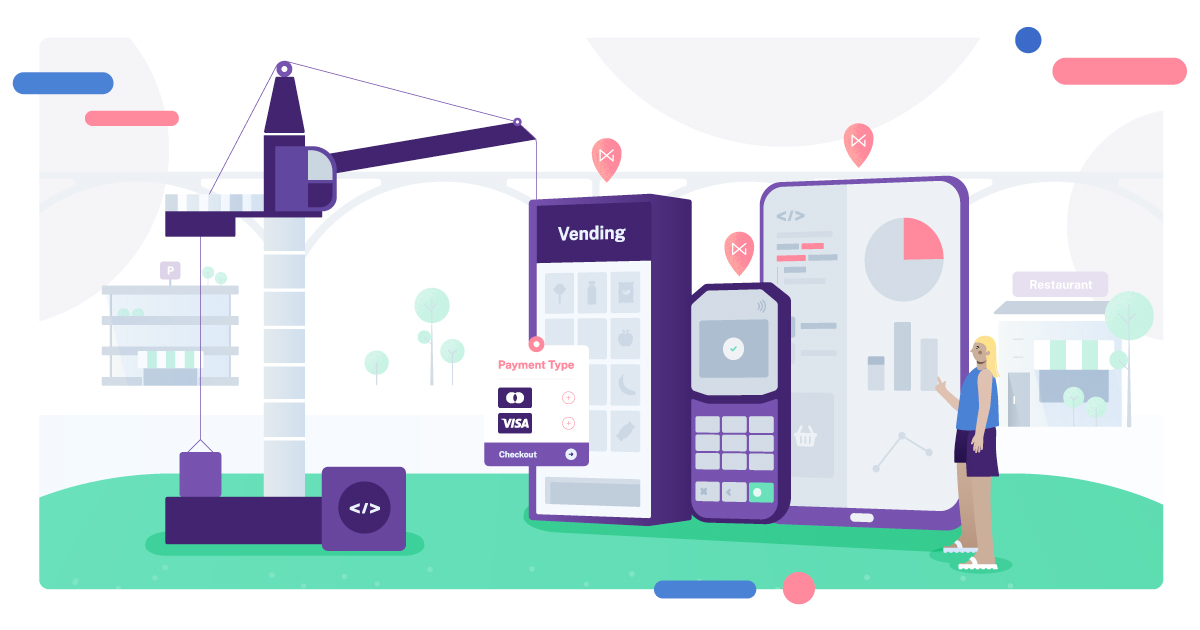Independent sales organizations (ISOs) and independent software vendors (ISVs) are parts of the payments ecosystem that, until recently, have served distinct roles. ISOs provide the processing and services merchants need to accept online and offline payments. ISVs, on the other hand, develop and sell software solutions that often require a payment component.
Today, the lines between ISOs and ISVs are blurring. Many ISOs recognize the value of offering value-added software solutions to their customers and either hire developers in-house or partner with ISVs to create unique solutions. Simultaneously, more ISVs are looking to provide payment processing directly to merchants and are looking for partners who can help them enable in-app payment acceptance.
What are ISOs?
Independent sales organizations are merchant services resellers that offer payment processing and value-added services to businesses. Primarily, ISOs sell credit card processing and payment acceptance support on behalf of acquiring banks or payment processors. They take responsibility for merchant recruiting, sales and support so their partners can focus on keeping things running smoothly behind the scenes.
In many cases, the division of duties between an ISO and their processing partner is so well defined that a merchant may not realize other parties are involved; their ISO is the sole point of contact for the lifetime of their processing needs.
In addition to managing merchant accounts, ISOs also commonly sell payment hardware, gateway software and a variety of optional add-on services. These services range from fraud detection systems and better data security to third-party software integrations and innovative payment options.
How Do ISOs Make Money?
ISOs make their money through residuals – tiny commissions earned on each transaction processed by a merchant they recruited.
Whenever a merchant accepts a credit or debit card payment, they must pay a small flat fee and a percentage of the overall transaction value. ISOs earn a portion of that fee, which represents a fraction of each transaction.
Profits can add up quickly since ISOs earn residuals for the lifetime of a merchant’s processing. Over time, ISOs can build huge portfolios of passive residuals worth millions of dollars annually.
What are ISVs?
An independent software vendor is any company that makes and distributes software or mobile applications. They operate in all industries. Every operating system, every app in the Apple and Google stores, every video game, every business tool – anything that can run on a computer or mobile device is the product of an ISV.
Today, thanks to the Internet of Things (IoT), almost everything relies on software to some extent.
ISVs are important partners in the payment processing space – especially those that develop software solutions for merchant businesses. By partnering with payments providers, some ISVs are expanding their tech stacks with tools that merchants can use to enhance payments. These tools may include advanced fraud detection, more robust reporting and analytics, stronger encryption and more.
How do ISVs Traditionally Make Money?
With traditional software sales, a buyer would pay upfront and own the software for as long as it worked or until they were ready to upgrade. Today, ISVs generate revenue in several ways, including one-time sales, monthly subscriptions, free or freemium distribution and mixed models combining multiple purchase options.
One-time purchase: Operating systems like Windows are great examples of one-time purchase software. Once purchased, a Windows license never expires; the owner can use the software for as long as computers support it.
Recurring subscriptions: Recurring subscriptions have become the norm for most higher-cost software. From enterprise systems like CRMs (customer relationship management solutions) to creative tools like Adobe Suite, most major software is now delivered over the cloud and billed monthly instead of sold outright and installed locally. This model reduces the upfront cost for customers but offers more long-term revenue to software providers.
Free and freemium: Some software solutions – like most mobile apps – are given away for free. Instead of charging an upfront cost, software vendors generate revenue from ads or optional in-app purchases that unlock additional premium features (known as the “freemium” model).
Hybrid models: In some cases, users pay a single upfront purchase price and have the option to make in-software purchases. Many popular video games work on this model, with players buying the game upfront and then having the chance to enhance gameplay with downloadable content (DLC), like unique characters, useful items, experience upgrades, new levels and more.
How ISVs are Moving Deeper Into the Payments Space
ISVs used to handle payments like any other merchant. They signed up for payment processing through an ISO or bank; if they sold tools that allowed their customers to take payments, those customers were on the hook for their own processing. The ISV’s revenue and the customer’s revenue were separate.
Today, many forward-thinking ISVs have realized that leaving customers to hunt down third-party payment processing is a wasted opportunity. Instead, they can offer it themselves to improve the customer experience and generate recurring profits.
Integrating payment acceptance into a software solution is called “embedded payments.” Embedded payments are part of the larger ecosystem of embedded finance and represent a substantial opportunity for software developers and vendors.
A recent study by Bain & Company found that “Revenue opportunities for software platforms and the enabling infrastructure providers that power these embedded offerings will more than double from $21 billion in 2021 to $51 billion in 2026. The transaction value of embedded finance will also surge $7 trillion in 2026 and account for 10% of U.S. financial transactions.”

A high-profile example of this model would be Shopify. Shopify’s original ecommerce site builder had no native payment capability. Instead, sellers needed a third-party payment system.
It didn’t take long for Shopify to realize that it could streamline its clients’ experience and tap into a substantial new revenue source if it became a payments provider rather than just integrating with them. Soon, Shopify Payments was born.
Shopify is just one example of an ISV looking to vertically integrate native payments into software to improve UX and capture revenue they would otherwise lose to outside companies. Today, instead of software providers depending on ISOs for payment processing, many become ISOs themselves. In other cases, they opt for a newer option – the PayFac model.
What Is the PayFac Model?
The payment facilitator (PayFac) model is a relatively new trend in payments. It parallels the ISO model but with some key differences. ISOs and PayFacs both resell payment processing, but PayFacs do so in a way that can make the model much more attractive, particularly to software providers.
ISOs are intermediaries that resell merchant services before passing the processing to a larger payment processor or bank. PayFacs, on the other hand, resell payment processing through their personal merchant ID (MID). They are master merchants who process customer transactions through their own merchant accounts.
Why would an ISV choose the PayFac model? Autonomy.
Because PayFacs process sub-merchant transactions through their own master merchant account, they are wholly responsible for underwriting, sub-merchant selection and any potential losses that may arise.
The upside of that arrangement is that PayFacs have near total control over which merchants they choose to work with – a critical factor for software vendors looking to offer payment services to everyone (or nearly everyone) that uses their products.
As the lines between ISOs and software vendors blur, a new world of opportunities will open for everyone in the payment space. Whether you’re a tech-savvy ISO or a software provider looking to integrate payment capabilities into their app or platform, we’re here to help.
To learn more about embedded payments, the pros and cons of the PayFac model and how NMI can take your software or ISO business to the next level, reach out to a member of our team to schedule a consultation.
Don’t just turn on payments, transform the way you do business
- Generate New Revenue By adding or expanding payment offerings to your solution, you can start earning higher monthly and transaction-based recurring revenue.
- Offer the Power of Choice Allow merchants to choose from 125+ shopping cart integrations and 200+ processor options to streamline their onboarding.
- Seamless White Labeling Make the platform an extension of your brand by adding your logo, colors and customizing your URL.




